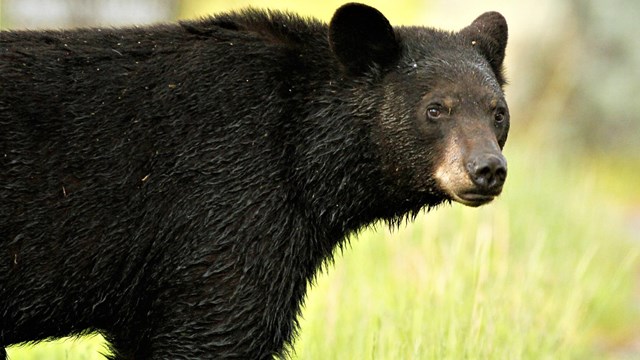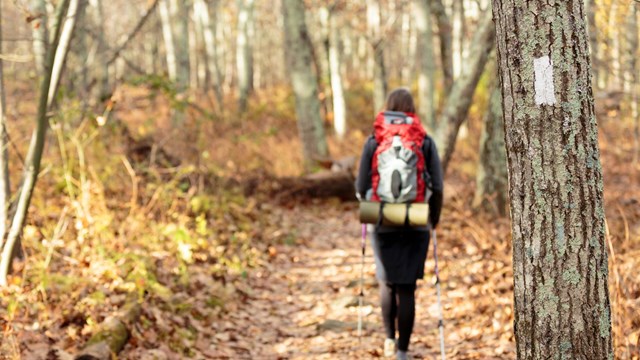Plan for your trip
Planning ahead can help ensure that your trip to Shenandoah is safe and enjoyable. Make sure that you're familiar with the risks associated with your next adventure and what you can do to keep yourself and your loved ones safe. Just a few minutes in preparation can make all the difference! Browse safety topics below to prepare for your next trip.
In the case of an emergency, dial 911 or call Park dispatch at 1-800-732-0911. Slips, trips and falls can happen at any time, but observing the following guidelines can minimize the likelihood of a serious injury while hiking in Shenandoah:
Believe it or not, storing your food properly while in Shenandoah is one of the most important steps you can take to protect wildlife and help keep yourself safe. Allowing a bear, or any other wild animal, to obtain human food, even once, can lead to aggressive behavior. An aggressive animal that associates humans with food is a threat to human safety, requiring the removal or killing of the animal.
Getting too close, feeding, and touching are all things that can put you and your furry, feathered, or scaled counterpart in grave danger. Keep these tips in mind for your next animal encounter:
Explore our Viewing & Photographing Wildlife page for tips for finding and photographing wildlife safely. When visiting the Park, you may spot a bear while hiking, camping, or simply walking between your car and the lodge for dinner. If you do spot one:
Bears are attracted to food and other scented items. Storing your food properly is one of the most important steps you can take to protect wildlife and help keep yourself safe. Read more about bear safety and how to report an inccident on our Bear Safety page. Ticks are small — so small, in fact, that they can be very difficult to see with the naked eye. Therein lies the danger. Several species of ticks are common throughout the Park, and they can transmit diseases to humans through a bite. It's important to take precautions whenever you are out exploring the Park, even if you're just taking a short stroll through nature.
Poison ivy grows plentifully along roadsides, trails, and the edges of parking lots as a vine or a low shrub. Most people are sensitive in varying degrees to the sap of this plant, which makes skin itch, blister, and swell. Because of this, it's important to learn to identify it so that you can avoid it if you see it out in the Park. If it does touch your skin, wash the area with soap and water as soon as possible, as the sap can penetrate your skin in only a few minutes.
Along with 16 species of non-venomous snakes, there are two species of venomous snakes found in Shenandoah National Park: timber rattlesnakes and copperheads. Snakes tend to be elusive, secretive animals, but you may come across one basking in a sun patch on top of a rock or in the middle of a hiking trail. While they won't go out of their way to attack you, you do need to be alert and watch your step. Be careful walking through dead leaves and turning over logs, as snakes can be hidden underneath. Since snakes are active at night, it's also important to use a flashlight or headlamp after dusk. If you do see a snake, leave it alone and give it a wide berth; all animals in the Park are protected by law!
First and formost, your pet must be on a physical leash no longer than 6 feet at all times. This is for their safety and yours during your adventure in Shenandoah. All hikes to waterfalls involve a hike downhill—and, of course, a harder hike back up! Never walk around on top of a waterfall - wet rocks are surprisingly slippery and, unfortunately, there have been several serious or fatal injuries around our waterfalls.
No hunting is allowed inside Shenandoah National Park, however several trails and gravel roads connect Shenandoah to the Rapidan Wildlife Management Area and private property where hunting is allowed. Be sure to wear blaze orange if hiking in the surrounding area during hunting season. Visit the Virginia Department of Wildlife Resources to learn more about hunting regulations and seasons.
Prevention is the key! Check the weather ahead of time, and avoid high places during anticipated storms. If you find yourself out during a lightning storm, follow these tips:
The speed limit is 35 mph in most places, and animals like deer, black bear, wild turkey, and a host of other woodland animals regularly cross Skyline Drive in their daily travels. Watch carefully for these animals who may dart across your path without warning. If you want to stop to view wildlife, be sure to pull completely off the road (all 4 wheels) and stay in your vehicle. Driving Skyline Drive in the WinterSkyline Drive remains open throughout the winter, unless it is closed due to snowy or icy conditions. Because of cold mountain temperatures, it can take diligent work crews several days to reopen Skyline Drive after winter storms. If the Drive is open, however, here are a few things to keep in mind when driving through the Park in the winter:
|
Last updated: April 17, 2023


